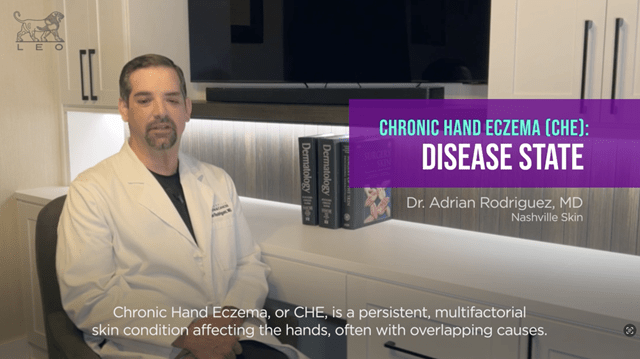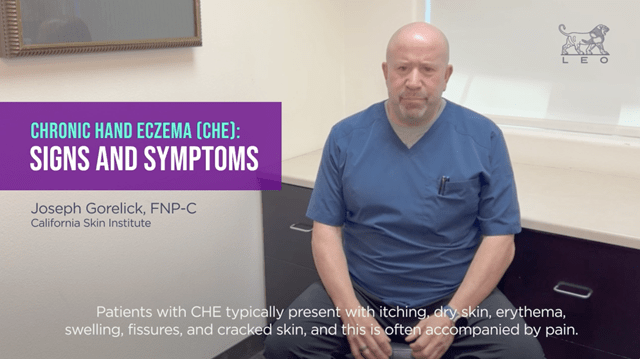Biological
Female sex
Atopic dermatitis
Childhood eczema
Low age at onset of hand eczema
Genetic mutations
Contact allergy
Learn about the first and only FDA-approved treatment for adults with moderate-to-severe chronic hand eczema (CHE)

You know it’s chronic hand eczema (CHE) when the eczema on your patients’ hands and wrists has
lasted for
MORE THAN
3 MONTHS1

relapsed
MORE THAN
TWICE A YEAR1

What is CHE? How prevalent is it? What is its pathophysiology? Watch to learn the fundamentals of this disease.
Chronic hand eczema is not an uncommon skin disease, with an overall self-reported physician-diagnosed prevalence of 4.7% in the general population.2,3
Patients with CHE may present with multiple subtypes, including atopic dermatitis.1
Chronic hand eczema expresses itself in a language all its own, with signs and symptoms that include4


How does CHE differ from atopic dermatitis of the hands? Get to know the typical signs and distinguishing features of this disease.


But now, the 1st and only FDA-approved treatment for chronic hand eczema is here.7-10
Biological
Female sex
Atopic dermatitis
Childhood eczema
Low age at onset of hand eczema
Genetic mutations
Contact allergy
Environmental
Wet work
Occupational or domestic exposure (prolonged exposure to irritants)
Climate (cold/dry conditions)
Lifestyle
Tobacco use
Stress

What are the risk factors of CHE? Are certain people or certain occupations more susceptible than others? Watch to find out.


“When there are cracks, even at work and all, it also hurts when you move the hands.”
— Patient with CHE11
CHE negatively impacts patients’ quality of life, often bringing on5,12
Anxiety
Low self-esteem
Social phobia
Embarrassment
Self-isolation

76%...reported it affected their social or leisure activities

38%...felt it impacted their engagement in activities

79%...stated it had a negative effect on their mood
“If my hands and fingers clear up completely, then I will be able to play the guitar again.”
— Patient with CHE11
References: 1. Thyssen JP, et al. Contact Dermatitis. 2022;86(5):357-378. doi:10.1111/cod.14035 2. Lee GR, et al. Dermatol Ther. 2019;32(3):e12840. doi:10.1111/dth.12840 3. Apfelbacher C, et al. Prevalence of chronic hand eczema in adults: A cross sectional multi-national study of over 60,000 respondents in the general population. Poster presented at: The Congress of the European Society of Contact Dermatitis (ESCD); September 4-7, 2024; Dresden, Germany. 4. Grant L, et al. Adv Ther. 2020;37(2):692-706. doi:10.1007/s12325-019-01164-5 5. Lynde C, et al. J Cutan Med Surg. 2010;14(6):267-284. doi:10.2310/7750.2010.09094 6. Mirabelli MC, et al. Contact Dermatitis. 2012;66(4):188-196. doi:10.1111/j.1600-0536.2011.02023.x 7. Dubin C, et al. Ther Clin Risk Manag. 2020;16:1319-1332. doi:10.2147/TCRM.S292504 8. ANZUPGO. Prescribing information. LEO Pharma Inc. 9. OPZELURA Prescribing information. Wilmington, DE: Incyte Corporation. 10. Samuel C, et al. Dermatol Ther (Heidelb). 2023;13(3):729-749. doi:10.1007/s13555-023-00892-5 11. Rönsch H, et al. J Eur Acad Dermatol Venereol. 2023;37(7):1396-1405. doi:10.1111/jdv.19055 12. Agner T, et al. J Eur Acad Dermatol Venereol. 2020;34(suppl 1):4-12. doi:10.1111/jdv.16061 13. Ahmed A, et al. Clin Exp Dermatol. 2015;40(5):495-501. doi:10.1111/ced.12619